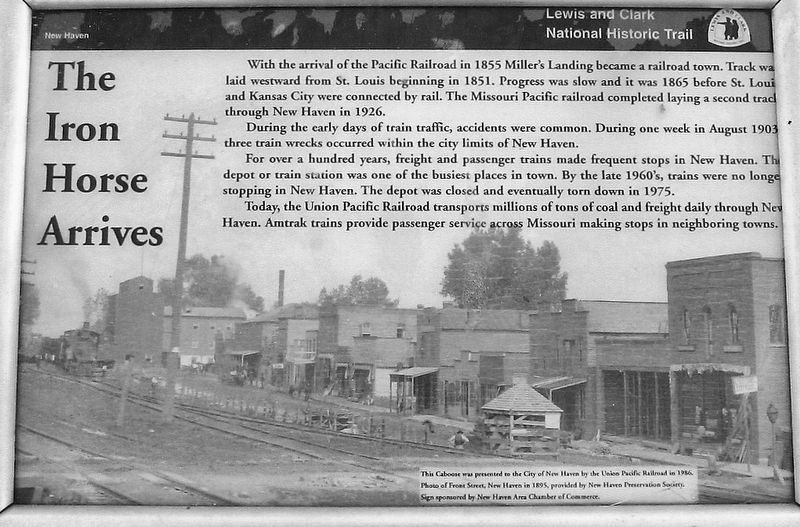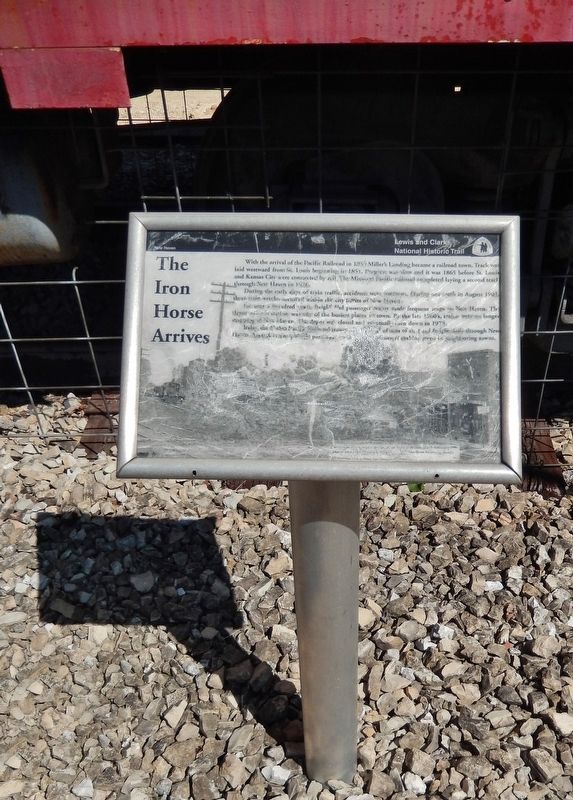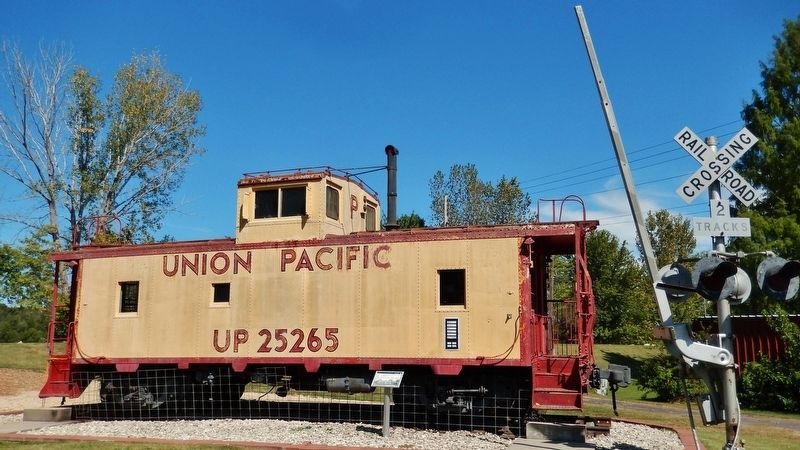New Haven in Franklin County, Missouri — The American Midwest (Upper Plains)
The Iron Horse Arrives
New Haven
— Lewis and Clark National Historic Trail —
With the arrival of the Pacific Railroad in 1855 Miller's Landing became a railroad town. Track was laid westward from St. Louis beginning in 1851. Progress was slow and it was 1865 before St. Louis and Kansas City were connected by rail. The Missouri Pacific railroad completed laying a second track through New Haven in 1926.
During the early days of train traffic, accidents were common. During one week in August 1903 three train wrecks occurred within the city limits of New Haven.
For over a hundred years, freight and passenger trains made frequent stops in New Haven. The depot or train station was one of the busiest places in town. By the late 1960's trains were no longer stopping in New Haven. The depot was closed and eventually torn down in 1975.
Today, the Union Pacific Railroad transports millions of tons of coal and freight daily through New Haven. Amtrak trains provide passenger service across Missouri making stops in neighboring towns.
Photo of Front Street, New Haven in 1895, provided by New Haven Preservation Society.
Marker sponsored by the New Haven Area Chamber of Commerce.
Erected by National Park Service, U.S. Department of the Interior.
Topics. This historical marker is listed in these topic lists: Industry & Commerce • Railroads & Streetcars. A significant historical year for this entry is 1855.
Location. 38° 36.881′ N, 91° 12.763′ W. Marker is in New Haven, Missouri, in Franklin County. Marker is on Main Street west of Cottonwood Street, on the left when traveling east. Marker is located at the east end of John Colter Memorial Park, directly in front of a restored Union Pacific caboose. Touch for map. Marker is in this post office area: New Haven MO 63068, United States of America. Touch for directions.
Other nearby markers. At least 8 other markers are within walking distance of this marker. Historic New Haven (within shouting distance of this marker); From the Mountains to Missouri (within shouting distance of this marker); Private John Colter (within shouting distance of this marker); The Lewis and Clark Expedition (within shouting distance of this marker); a different marker also named Private John Colter (within shouting distance of this marker); Colter's Escape from the Blackfeet (within shouting distance of this marker); "The Mighty Missouri" (within shouting distance of this marker); a different marker also named Private John Colter (within shouting distance of this marker). Touch for a list and map of all markers in New Haven.
Also see . . .
1. From steamship to railroad, New Haven has seen it all. New Haven Area Chamber of Congress website entry:
New Haven was founded in 1836 as a riverboat stop on the Missouri River called Miller's Landing. Founder Phillip Miller operated a wood yard on the river to fuel the steamboat trade. The arrival of the 'Iron Horse' Union Pacific Railroad in the 1850s brought more commerce and activity to the area. Due to this growth, the name was changed in 1856 to New Haven to reflect the movement away from steamships. (Submitted on August 8, 2018, by Cosmos Mariner of Cape Canaveral, Florida.)
2. New Haven Residential Historic District. Living Places website entry:
New Haven was platted and lots laid out in 1856. The original section of the town included only the area below the bluff and adjacent to the Missouri River. Another addition was made to the community the following year on the bluff area including sections of what are now Wall Street and Maupin Avenue. The German immigration to New Haven was part of the widespread settlement of Germans to the Missouri River valley in the mid-19th century. Motivated by political and economic change then occurring in central Europe, many German families were drawn to Missouri by the descriptions written by native German Gottfried Duden. Upon arriving in St. Louis via New Orleans, immigrants traveled westward into the Missouri River valley. Many chose to travel by steamboat and the communities of Washington, New Haven, and Hermann received many of these immigrant families. (Submitted on August 9, 2018, by Cosmos Mariner of Cape Canaveral, Florida.)
Credits. This page was last revised on December 28, 2022. It was originally submitted on August 7, 2018, by Cosmos Mariner of Cape Canaveral, Florida. This page has been viewed 276 times since then and 24 times this year. Photos: 1, 2, 3, 4. submitted on August 8, 2018, by Cosmos Mariner of Cape Canaveral, Florida. • Bill Pfingsten was the editor who published this page.



